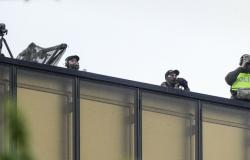In the book “Spionkrigen – The secret spy collaboration between Norway and the USA”, the former NRK journalist Bård Wormdal takes us on a journey into a secret world.
The journey goes from the clearly visible US-funded radar domes in Vardø to camouflaged cabins and barns in hidden fjord arms, listening cables and fishing boats with secret rooms and tasks.
Wormdal allows us to meet former intelligence and defense chiefs, a number of current employees of the National Intelligence Service, veterans who have lived double lives, and worried neighbors of facilities that are obvious bomb targets.
The book tells about dramatic spy trips across the border to Russia, about the National Intelligence Service’s eternal attempts to recruit agents and about those who had to pay a high price after ending up in the spotlight of Russian intelligence.
Extensive material
Using extensive source material, including large amounts of classified documents leaked by the American whistleblower Edward Snowden, Wormdal documents an intelligence collaboration with the United States that is far more extensive than previously known.
Also read: Review: “Strictly confidential”: Norwegian diplomats outplayed
In the book, he mentions, among other things, an advanced facility at Eggemoen outside Hønefoss, where the Norwegian Intelligence Service, in close cooperation with the American intelligence organization NSA, has since 2005 tapped enormous amounts of data from around 130 civilian communication satellites.
The Storting’s control committee for the intelligence and security services, the EOS committee, has repeatedly questioned whether this collection may be in breach of Norwegian law. The intelligence service, which has no opportunity to spy on Norwegian citizens, has rejected this.
Such satellite monitoring also takes place from three other facilities in Norway, one near Hønefoss, one at Vetan on Fauske and one at Barhaug in Sør-Varanger, writes Wormdal.
Tapping of data traffic
The intelligence service also wants to tap the fiber cables through which all data traffic to and from Norway passes, and in 2020 the Storting passed a new law which opened up both this and the storage of obtained material for up to 15 years.
However, in the same year, the EU Court ruled that such mass storage of data is not permitted without suspicion, and the new Norwegian law therefore had to be changed.
Also read: Biden meets congressional leaders to avert debt chaos
The law has now been revised and will ensure increased judicial control, but the Norwegian Data Protection Authority, Amnesty, ICT Norway and computer experts at Tekna are still highly critical.
So is the media group Schibsted’s main owner, the Tinius Foundation, which claims the law is an attack on privacy and freedom of expression and has notified a lawsuit against the State.
Cyber attacks against other countries
Wormdal also questions the fact that in 2019 the National Intelligence Service received the green light from the Storting to conduct so-called offensive cyber operations, that is to say carry out computer attacks against other countries.
The guidelines for such attacks were drawn up all the way back in 2014 and allow for damage to both material and people in other countries, even if Norway has not been attacked.
Shortly after the Storting’s decision, the Norwegian Intelligence Service began recruiting computer experts, some of them hackers straight out of high school.
– Did the individual parliamentary representative know that she or he had agreed to give young people permission to develop computer codes and viruses to attack computer systems in other countries? Did they know what they had given their approval to, asks Wormdal in the book.
– Such offensive cyber operations are not regulated by Norwegian law, but must of course be carried out within the framework of international law, says the National Intelligence Service’s communications officer Ann-Kristin Bjergene to NTB.
Generous monetary contributions
The USA’s central role in the financing of the Norwegian Intelligence Service’s facilities and operations in Norway is also given space in the book. Professor Tormod Heier at the Norwegian Defense Academy, who himself has a background in the service, has estimated that in the mid-1990s the USA paid more than 90 percent of the budget to Norwegian intelligence.
The monetary contributions were for many years so high that the Norwegian Intelligence Service was unable to use them up, and large amounts therefore had to be returned to an account in the USA, a source tells Wormdal.
Also read: The solar cells cut electricity production when the sun conditions are best
– It has not been possible to find out how large sums the US injects into the Intelligence Service today, he writes.
The American investments in facilities have undoubtedly been enormous, including for the Globus III radar in Vardø. According to estimates, this alone has cost NOK 10 billion, around three times as much as the official budget for the Norwegian Intelligence Service in 2023.
According to Wormdal, the US has also invested heavily in the facility at Eggemoen, and there is now a significant American presence at both locations.
Lack of control
In the book, Wormdal documents how important Norway has been for American intelligence, primarily by monitoring Russian activity in the northern regions. He also points out that Norwegian politicians have long requested information about which agreements have been concluded, but without getting a proper answer.
Over the years, the Storting’s EOS committee has not received answers to all its questions. The committee also only has the capacity to take random samples, and several former managers and members express their frustration to Wormdal at the lack of capacity.
When the EOS committee came unannounced in 2013 to inspect the Harbor Warehouse in Oslo, following a tip-off that the National Intelligence Service had a secret archive there, they were refused entry. Only later did the committee see an edited version of the archive.
The committee itself has characterized the National Intelligence Service’s unwillingness to provide statutory access as “challenging and fundamentally questionable”, and so have several of the parties in the Storting.
The Norwegian Intelligence Service does not wish to comment on this criticism towards NTB.
Tags: book reveals unknown aspects spying cooperation United States
-





